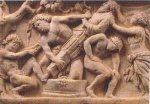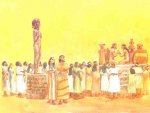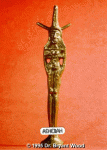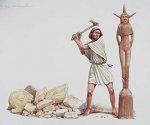P
A passage from Jeremiah 10 is frequently pointed out by, I'm sure, very sincere and well-meaning students as evidence that the Christmas tree is a pagan symbol, so I would like to present the historical and archaeological evidence in light of this criticism.
Jeremiah 10 speaks of an idol or image that was frequently used throughout the ancient land of Canaan and is referred to by archaeologists and the foremost scholars on ancient Judean/Sumerian religions as “Judean pillar-figurines,” or “Asherah poles.” The specific Hebrew term used in Scripture is the plural form “Asherim” as they were invariably idols of the regional goddess Asherah. These idols are mentioned in several Old Testament books; Exodus, Deuteronomy, Judges, the Kings, the Chronicles, Isaiah, Jeremiah and Micah, and they played a large role in the religious worship practices of the region. These "Asherim" are translated in the King James Version as “groves” giving an erroneous impression of a grove or stand of trees, but the New Revised Standard Version translates them more accurately as “poles," rightly conveying the idea that these images were in fact Mediterranean style totem poles, objects carved from a solid length of tree trunk, or a “stock," which is the word used in Jeremiah 10.
These Canaanite "totem poles" varied in length and size, depending on the type and size of the tree used, and were variously decorated depending upon the wealth and artistic ability of the manufacturer. They contained images carved into the wood, faces and bodies of the local deities, in the case of the ancient Canaanite lands the goddess Asherah, and they could be decorated with silver and gold plating and adorned with fine purple clothing. They could also be made from stone pillars or columns of various sizes and lengths, ergo the archaeological reference to "pillar figurines."
Asherah poles made of wood have not survived, so the only knowledge we have of them is from ancient writings and archaeological artifacts. However, a carving on a stone sarcophagus depicts a pillar-figurine of the god Dionysus, shown being raised up to be dropped into a stand that was fashioned to make it stand upright, exactly as described in Jeremiah about the Asherah poles. Very often in the Old Testament Scriptures the prophets of God mocked these "gods" who had eyes but could not see, ears but could not hear, a mouth that could not speak, and feet but had to be carried everywhere they went and fastened in a stand so they could stand upright . . .
“The customs of the people are vain: for one cutteth a tree out of the forest, the work of the hands of the workman, with the axe. They deck it with silver and with gold; they fasten it with nails and with hammers, that it move not. They are upright as the palm tree, but speak not: they must needs be carried, because they cannot go. Be not afraid of them; for they cannot do evil, neither can they do good.”

Well and truly did the prophet Jeremiah say of these false gods made by artisans and "cunning workmen": "They are altogether brutish and foolish: the stock is a doctrine of vanities. Silver spread into plates is brought from Tarshish, and gold from Uphaz, the work of the workman, and of the hands of the founder: blue and purple is their clothing: they are all the work of cunning men ... thus shall ye say unto them, The gods that have not made the heavens and the earth, even they shall perish from the earth, and from under these heavens." Jeremiah 10:8-11
To this day not one splinter remains of these "gods" which once towered above and lorded it over the heads of the people who, after fashioning them with their own hands, foolishly bowed down to worship them as gods.

Hundreds of smaller replicas of these idols have been discovered in recent decades in archaeological digs throughout Israel, the personal or household version of the larger images that stood near the altars of the various gods they represented.

Throughout Jewish history of this period these icons presented a real stumbling block to the Jews and the Hebrew Scriptures are replete with condemnation and warnings against this practice and the inclusion of smaller versions of these icons in the homes of the Jewish people. And yet, even having seen visible proof of the reality of "I Am," the Jews at times turned from worshipping Him and took up with these man-made gods. In fact, they were so prone to it that God specifically commanded them not to make any carved images of anything . . . to point out the folly of man fashioning his own gods which he can see rather than worshipping the Creator whom he cannot see.
God repeatedly warned the Jews not to take part in this idolatry, even going so far as to instruct Gideon in Judges 6 to cut down the asherah poles that stood beside the altar of Baal and to burn them for a burnt offering!

For the most thorough treatment of these Asherah poles please see the important work by Raz Kletter of the Israel Antiquities Authority, the foremost archaeologist and scholar on Bronze and Iron Age archaeology and Biblical archaeology:
Studies in the Archaeology of the Iron Age in Israel and Jordan - Amihay Mazar - Google Books
The Christmas Tree ~
The Asherah poles, or Judean pillar-figurines, have no historical connection to Christmas trees. In point of fact, the farthest back the use of Christmas trees can be traced historically is back to at most about 400 years ago, in late 1600's Germany.
During this period throughout Europe the common people generally had no formal education and could neither read nor write, but they could not have read the Bible even so because the church, believing the common man could not understand the Scriptures and would misuse or abuse them, only allowed the Bible to be recorded in Latin while the native tongue spoken by the people was German and English. Even the rites and ceremonial of the church was performed in Latin leaving the people woefully ignorant of the Scriptures. So many of the common people actually gained their knowledge of Bible stories from the entertainment media of the day, traveling troupes of minstrels and actors.
Many of the plays and skits that these troupes performed were Bible stories and by all accounts from history the "Paradise Play" about the creation and the fall, performed at the Christmas season, was one of the most popular. History has it that, traveling the countryside in donkey carts, these minstrels had to keep props to a minimum, so for this particular play an evergreen tree was cut down and used as a prop in the play to represent, in the first scene, the Tree of Knowledge, hung with the common apple readily available during this season (which is where the idea of the apple being the forbidden fruit comes from). And later, in another act, the same tree was used to represent the Tree of Life, this time hung with sweets and wafers representing the gifts of salvation. In the years after these plays were no longer being performed, Christians began to erect their own “Paradise Tree” during the Christmas season to teach children about the fall and redemption of man. Eventually other items were added to the tree to further symoblize the doctrines of the faith, such as lights to represent that the birth of Jesus is a "light come into the world," and topped with either a star or an angel representing the star of Bethlehem and the angelic choir which heralded Jesus' birth.
For an introduction to the history of the Paradise Play please refer to "Drama, Paradise Play from Medieval Germany: An Encyclopedia (beginning with the bottom portion of page 294):
http://books.google.com/books?id=0Sdo1gNF4D8C&pg=PA295&lpg=PA295&dq=paradise+plays+from+medieval+germany&source=bl&ots=XlNunqJJCg&sig=VeRxYb7UtuchMSOzJyYD3B1GPjs&hl=en&sa=X&ei=wdK8UJ_GLYOS9QTB5ID4CQ&sqi=2&ved=0CD0Q6AEwAw#
The first historical record of the use of a Christmas tree was written in a letter from a pilgrim in Germany who commented on a Christmas Tree being used in the small village of Alsace where he had visited at Christmas time. Within a few years the Christmas tree had rapidly spread throughout Germany. The Catholic Church at first objected to its use, but eventually Christmas trees became far too popular for even the Catholic Church to resist. But it wasn't until Queen Victoria and her husband, the German Prince Albert, put up the first Christmas tree in Great Britain in the 1800's that the Christmas tree's popularity spread beyond the Germanic peoples. A wood carving was produced depicting the royal family around their Christmas tree and a copy was published, the first historic instance of a Christmas "greeting" and the origins of the modern custom of exchanging Christmas Cards. This wood carving was copied in America and the reproduction was published in "Godey’s Lady’s Book," the “Good Housekeeping” of the 1800’s.

Within a few years, and with only minimal objections, Americans took to the Christmas tree with alacrity and today it has become a fixture in American culture not only among Christians, but even among those who otherwise do not celebrate the religious aspects of the holiday. Coupled with the gift giving (derived from the practice of the wise men who gave gifts to the Christ Child), carols (derived from the worship in song by the angelic choir and until the late 19th to 20th Century consisted entirely of hymns which formed part of every church's Christmas worship services) and feasting (the Bilical mode of religious celebration), Christmas has become a holiday which is celebrated around the world, even by cultures and people of other religions.
From an historical perspective, the Christmas tree is of a relatively recent invention of Christians only within the past four hundred years. Prior to that time there is no mention of the use of a Christmas tree in any historical or archaeological source, and certainly no ties to any ancient pagan idols.
In Christ,
Pilgrimer
Jeremiah 10 speaks of an idol or image that was frequently used throughout the ancient land of Canaan and is referred to by archaeologists and the foremost scholars on ancient Judean/Sumerian religions as “Judean pillar-figurines,” or “Asherah poles.” The specific Hebrew term used in Scripture is the plural form “Asherim” as they were invariably idols of the regional goddess Asherah. These idols are mentioned in several Old Testament books; Exodus, Deuteronomy, Judges, the Kings, the Chronicles, Isaiah, Jeremiah and Micah, and they played a large role in the religious worship practices of the region. These "Asherim" are translated in the King James Version as “groves” giving an erroneous impression of a grove or stand of trees, but the New Revised Standard Version translates them more accurately as “poles," rightly conveying the idea that these images were in fact Mediterranean style totem poles, objects carved from a solid length of tree trunk, or a “stock," which is the word used in Jeremiah 10.
These Canaanite "totem poles" varied in length and size, depending on the type and size of the tree used, and were variously decorated depending upon the wealth and artistic ability of the manufacturer. They contained images carved into the wood, faces and bodies of the local deities, in the case of the ancient Canaanite lands the goddess Asherah, and they could be decorated with silver and gold plating and adorned with fine purple clothing. They could also be made from stone pillars or columns of various sizes and lengths, ergo the archaeological reference to "pillar figurines."
Asherah poles made of wood have not survived, so the only knowledge we have of them is from ancient writings and archaeological artifacts. However, a carving on a stone sarcophagus depicts a pillar-figurine of the god Dionysus, shown being raised up to be dropped into a stand that was fashioned to make it stand upright, exactly as described in Jeremiah about the Asherah poles. Very often in the Old Testament Scriptures the prophets of God mocked these "gods" who had eyes but could not see, ears but could not hear, a mouth that could not speak, and feet but had to be carried everywhere they went and fastened in a stand so they could stand upright . . .
“The customs of the people are vain: for one cutteth a tree out of the forest, the work of the hands of the workman, with the axe. They deck it with silver and with gold; they fasten it with nails and with hammers, that it move not. They are upright as the palm tree, but speak not: they must needs be carried, because they cannot go. Be not afraid of them; for they cannot do evil, neither can they do good.”

Well and truly did the prophet Jeremiah say of these false gods made by artisans and "cunning workmen": "They are altogether brutish and foolish: the stock is a doctrine of vanities. Silver spread into plates is brought from Tarshish, and gold from Uphaz, the work of the workman, and of the hands of the founder: blue and purple is their clothing: they are all the work of cunning men ... thus shall ye say unto them, The gods that have not made the heavens and the earth, even they shall perish from the earth, and from under these heavens." Jeremiah 10:8-11
To this day not one splinter remains of these "gods" which once towered above and lorded it over the heads of the people who, after fashioning them with their own hands, foolishly bowed down to worship them as gods.

Hundreds of smaller replicas of these idols have been discovered in recent decades in archaeological digs throughout Israel, the personal or household version of the larger images that stood near the altars of the various gods they represented.

Throughout Jewish history of this period these icons presented a real stumbling block to the Jews and the Hebrew Scriptures are replete with condemnation and warnings against this practice and the inclusion of smaller versions of these icons in the homes of the Jewish people. And yet, even having seen visible proof of the reality of "I Am," the Jews at times turned from worshipping Him and took up with these man-made gods. In fact, they were so prone to it that God specifically commanded them not to make any carved images of anything . . . to point out the folly of man fashioning his own gods which he can see rather than worshipping the Creator whom he cannot see.
God repeatedly warned the Jews not to take part in this idolatry, even going so far as to instruct Gideon in Judges 6 to cut down the asherah poles that stood beside the altar of Baal and to burn them for a burnt offering!

For the most thorough treatment of these Asherah poles please see the important work by Raz Kletter of the Israel Antiquities Authority, the foremost archaeologist and scholar on Bronze and Iron Age archaeology and Biblical archaeology:
Studies in the Archaeology of the Iron Age in Israel and Jordan - Amihay Mazar - Google Books
The Christmas Tree ~
The Asherah poles, or Judean pillar-figurines, have no historical connection to Christmas trees. In point of fact, the farthest back the use of Christmas trees can be traced historically is back to at most about 400 years ago, in late 1600's Germany.
During this period throughout Europe the common people generally had no formal education and could neither read nor write, but they could not have read the Bible even so because the church, believing the common man could not understand the Scriptures and would misuse or abuse them, only allowed the Bible to be recorded in Latin while the native tongue spoken by the people was German and English. Even the rites and ceremonial of the church was performed in Latin leaving the people woefully ignorant of the Scriptures. So many of the common people actually gained their knowledge of Bible stories from the entertainment media of the day, traveling troupes of minstrels and actors.
Many of the plays and skits that these troupes performed were Bible stories and by all accounts from history the "Paradise Play" about the creation and the fall, performed at the Christmas season, was one of the most popular. History has it that, traveling the countryside in donkey carts, these minstrels had to keep props to a minimum, so for this particular play an evergreen tree was cut down and used as a prop in the play to represent, in the first scene, the Tree of Knowledge, hung with the common apple readily available during this season (which is where the idea of the apple being the forbidden fruit comes from). And later, in another act, the same tree was used to represent the Tree of Life, this time hung with sweets and wafers representing the gifts of salvation. In the years after these plays were no longer being performed, Christians began to erect their own “Paradise Tree” during the Christmas season to teach children about the fall and redemption of man. Eventually other items were added to the tree to further symoblize the doctrines of the faith, such as lights to represent that the birth of Jesus is a "light come into the world," and topped with either a star or an angel representing the star of Bethlehem and the angelic choir which heralded Jesus' birth.
For an introduction to the history of the Paradise Play please refer to "Drama, Paradise Play from Medieval Germany: An Encyclopedia (beginning with the bottom portion of page 294):
http://books.google.com/books?id=0Sdo1gNF4D8C&pg=PA295&lpg=PA295&dq=paradise+plays+from+medieval+germany&source=bl&ots=XlNunqJJCg&sig=VeRxYb7UtuchMSOzJyYD3B1GPjs&hl=en&sa=X&ei=wdK8UJ_GLYOS9QTB5ID4CQ&sqi=2&ved=0CD0Q6AEwAw#
The first historical record of the use of a Christmas tree was written in a letter from a pilgrim in Germany who commented on a Christmas Tree being used in the small village of Alsace where he had visited at Christmas time. Within a few years the Christmas tree had rapidly spread throughout Germany. The Catholic Church at first objected to its use, but eventually Christmas trees became far too popular for even the Catholic Church to resist. But it wasn't until Queen Victoria and her husband, the German Prince Albert, put up the first Christmas tree in Great Britain in the 1800's that the Christmas tree's popularity spread beyond the Germanic peoples. A wood carving was produced depicting the royal family around their Christmas tree and a copy was published, the first historic instance of a Christmas "greeting" and the origins of the modern custom of exchanging Christmas Cards. This wood carving was copied in America and the reproduction was published in "Godey’s Lady’s Book," the “Good Housekeeping” of the 1800’s.

Within a few years, and with only minimal objections, Americans took to the Christmas tree with alacrity and today it has become a fixture in American culture not only among Christians, but even among those who otherwise do not celebrate the religious aspects of the holiday. Coupled with the gift giving (derived from the practice of the wise men who gave gifts to the Christ Child), carols (derived from the worship in song by the angelic choir and until the late 19th to 20th Century consisted entirely of hymns which formed part of every church's Christmas worship services) and feasting (the Bilical mode of religious celebration), Christmas has become a holiday which is celebrated around the world, even by cultures and people of other religions.
From an historical perspective, the Christmas tree is of a relatively recent invention of Christians only within the past four hundred years. Prior to that time there is no mention of the use of a Christmas tree in any historical or archaeological source, and certainly no ties to any ancient pagan idols.
In Christ,
Pilgrimer
